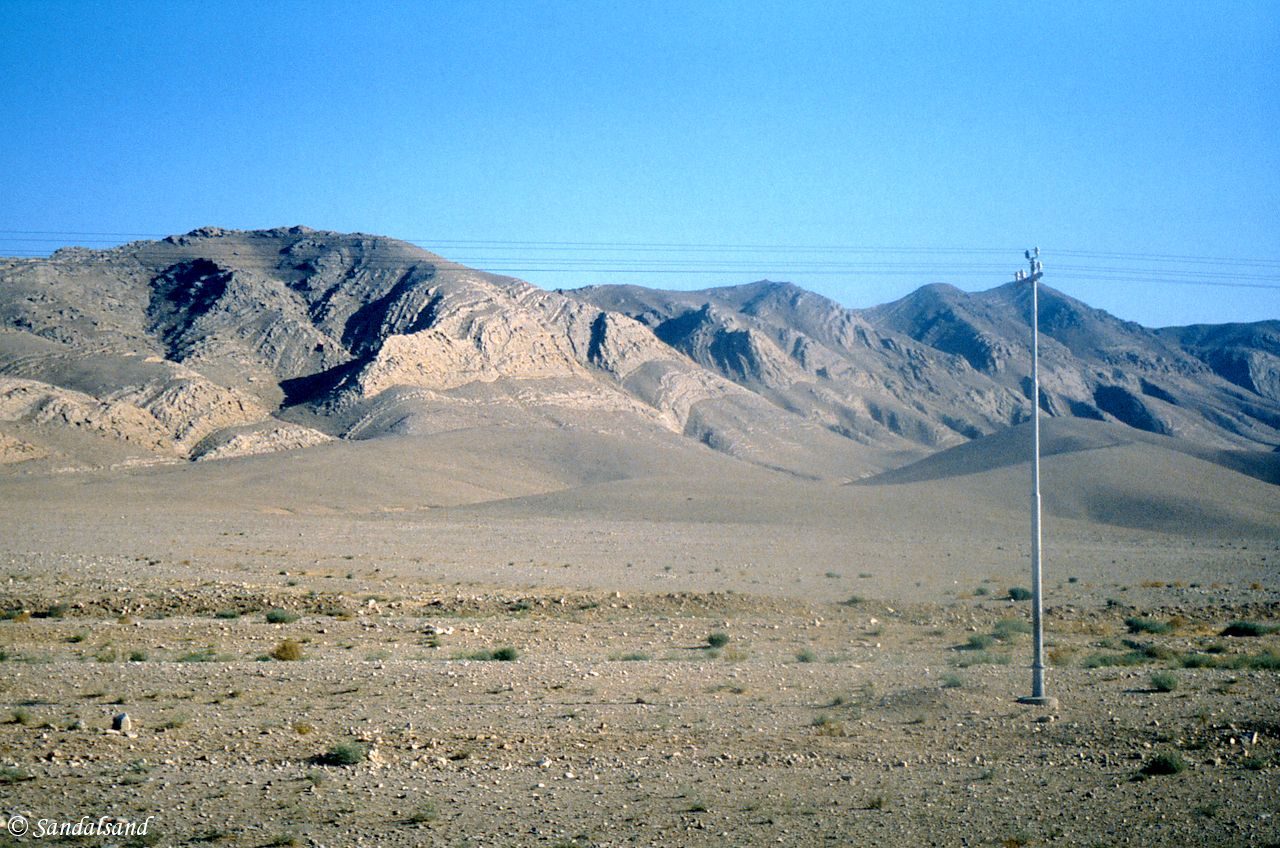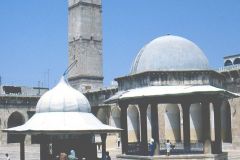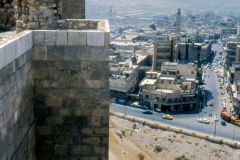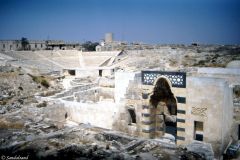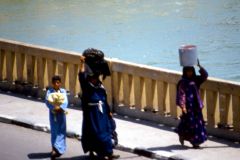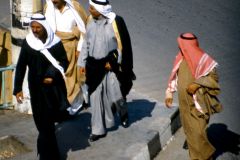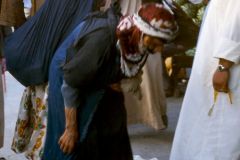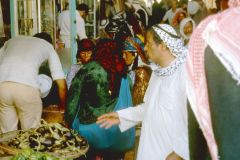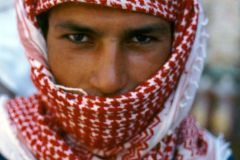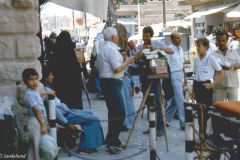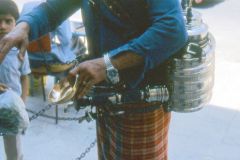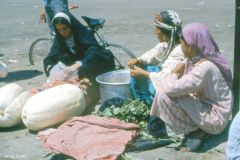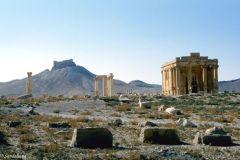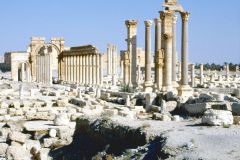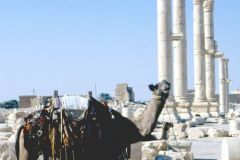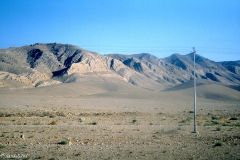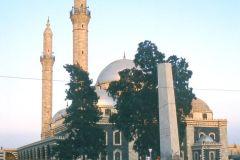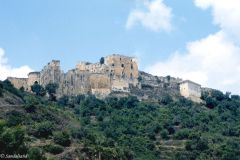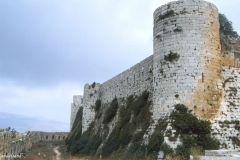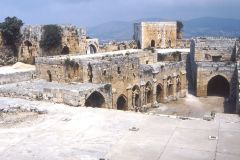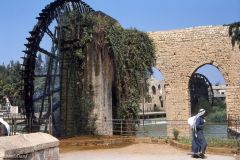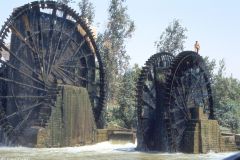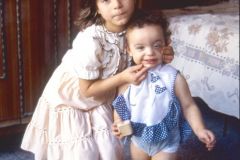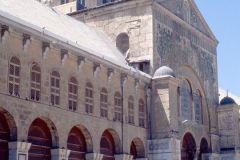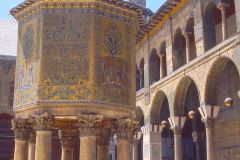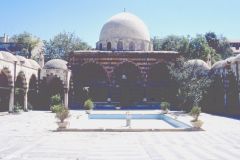Read about deserts, towns and memorials of Syria. Syria was a closed country, not welcoming tourists. But what an exciting past and present! In combination with an eagerness among young people to meet Westerners the stage was set for an exciting week.
This article is no. 3 of 5 in a series based on my travel diaries from 1986. I was on a five week journey to Turkey, Syria, Jordan and Israel / Palestina.
Tuesday 5.8.1986, Antakya – Aleppo
A long day, starting in Antakya
(In this text 1 USD = 10 SP/SL Syrian Pounds / Lira)
I arrived in Antakya with the bus from Ankara, Turkey around 7-8 in the morning. I got myself some breakfast and prepared to wait a few hours for the bus to Aleppo, Syria.
A taxi driver persuaded me however to go there by myself. A full bus would be crowded and time-consuming on the border. And the price would be just about the same, 7000 Turkish Liras. I took a taxi to the Turkish border post for 5000 TL, managed after a bit of waiting to get through and hitch-hiked with two Jordanians to the Syrian border post 4-5 km further east. I joined the queue at the police just to learn when I got first in line that I would have to go to the bank to get a receipt for having changed 100 USD – a prerequisite for all tourists.
So, I walked over to the bank which of course was temporarily closed for the breakfast break. I got through eventually and had some problems cashing in my travellers cheque because I didn’t bring the receipt from my bank back home. At last I managed. They wouldn’t change my Turkish lirasi back, and I had quite a few left, 25000. Back at the police border control I was told I had not received a tourist visa, only a 3 days transit visa. But they informed me that I would be able to extend in Aleppo.
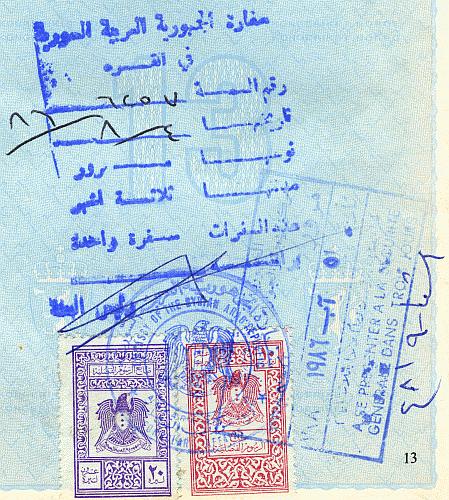
Crossing the border into Syria, and on to Aleppo
From the border there is no public transport to Aleppo, only taxis. After some waiting I joined three others in a taxi, among them a Syrian German-speaking salesman. After having paid 40 SP to the driver I was let off at a cheap hotel. It was full, but luckily there were other cheap hotels in the same area. I found:
- HOTEL ASSAL, by the Bab al Faraj Street. The rate was 25 SP for a single with sink. All right place, but basic toilet facilities. The hotel is close to a big clock tower, not far from the tourist office and the city sights. Several other cheap places nearby. Map
As I stepped into my room, two Dutch people came up to me, a brother and sister. We had a long conversation and agreed to go to the souq (bazaar) later in the afternoon. We did that for three hours. The souq in Aleppo is the world’s largest and very interesting and exciting. The siblings were leaving the next day and wanted to spend the rest of their money. And they really did some shopping. It was quite fun just to follow them along.
Getting settled
I met a black market dealer and got rid of my Turkish lirasi. (25 SL at 1000 TL gave me 625 SL for mine 25000). Black currency exchange is fairly widespread in this country, I hear. USD is traded for double the official rate. The dealers even take travellers cheques! But it is best to watch out, even though some police officers earn a few extra on the side acting on the black market.
In the evening I was waived out on the balcony by two guys in the hotel room next door. They turned out to be Syrian Kurds. It also turned out that they were proud of and conscious about their heritage. Sitting there on the balcony above a dark back yard eating fresh figs we had a long conversation about the life of their people and about Kurdistan. They expressed quite harsh criticism against President Assad and the government of this country in general, and especially against the oppressive policy against the Kurdish people. They were surprisingly open, which is not exactly common practice here in this country where “the walls have ears” as they put it themselves. Other people I met today were not so open.
Wednesday 6.8.1986, Aleppo
Getting a visa extension
I got up early to visit the police / immigration authorities. My objective was to extend my visa. That turned out to be easier said than done. It was not that the authorities were behaving in a bad manner, but there was a lot of paper work to be done.
On the way I met a young Syrian who had noticed a map I was looking at. He knew some English and offered his help. So we went to the Immigration office and were given some pieces of paper. Unfortunately I needed 5 pictures of me, which I did not possess. When I finally had got the five photos they said at the Immigration office that they had closed at 12 noon and would reopen again the next morning. In the meantime Hassan and I had walked around a bit and he had introduced me to some friends of his. He was clearly proud of being a guide for a foreigner. He was from a wealthy family and in accordance with local custom he insisted on paying everything – lunch, pictures, taxi etc.
A private guide
Last night I met a policeman in my hotel. He spoke very little English, but we agreed to a sightseeing trip today. And we did. Aleppo is really an interesting city. Especially the souq – the world’s largest. I can’t tell for sure why the policeman in uniform wanted to guide me, but it seemed to be out of general interest in practising English.
It is exciting here among the Arabs. It is much more different from Europe here than in Turkey. Of course there are lots of Arabs with towels and rings on their heads. Plus long robes. The traffic is heavy and noisy. Lively atmosphere and trading. Lots of good nuts, fruits and shakes. The Baron Hotel, known from Lawrence of Arabia, is not far from my hotel. After dinner I went down there and had a bottle of good Syrian beer on the terrace outside. Just to have been there.
Thursday 7.8.1986, Aleppo
Early off to the Immigration office. After a bit of waiting I received the necessary signatures and when I picked up my passport around 1300 I had got a visa lasting until the 30th of August. Excellent. I said goodbye to Hassan after he had helped me buy a bus ticket to Deir-ez-Zor at the Euphrates River in Eastern Syria (32 SL).
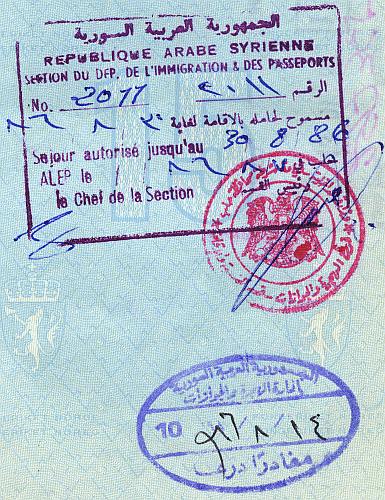
In the evening I bought some cheap but delicious cakes, had some tea sent up to my room and started writing postcards home. I was however interrupted by a nice hotel assistant. His name was Ahmed and we exchanged pictures.
Friday 8.8.1986, Aleppo – Deir-ez-Zor
The bus from Aleppo to Deir-ez-Zor in the far east of Syria took around 4 hours. Two men knew some English and offered their help in finding a hotel.
- HOTEL DAMAS. Right by the souq and a bridge over to an island in the Euphrates. 16 SL for a dormitory. The room had a fine view with balcony over the river.
I agreed to meet the two young men at 20-21 years of age later in the afternoon. We walked around a bit and saw among other things a bridge over the Euphrates River. The bridge is the city’s sole official sight, but for my part the street life is equally colourful.
I got along very well with to law student O and the architecture student S. The latter is studying in Skopje, Yugoslavia. O is in Aleppo but is soon going to Cuba. We talked a lot, including politics. We went to O’s home. There two other friends dropped by. M is a student in Beirut. He said that a car bomb had killed a large number of people yesterday, near the University. His brother N is studying together with O. We had a lot of fun.
Saturday 9.8.1986, Deir-ez-Zor – Palmyra – Homs
O and S wanted me to stay longer in Deir-ez-Zor, but I thanked no. I had to go on. I took a bus (2,5 hours) to Palmyra, Syria’s most famous sight. The city of Queen Zonabia and others was a hub for trade (and wars) thousands of years ago. The buildings and what we today see, dates back to the first three centuries AD.
On the road we saw very unfertile desert and the oasis Palmyra (today: Tadmor) must have been a sought after breathing hole for the wayfarers of that time. I did not get much time to breathe as I bought a ticket onwards to Homs an hour after arrival. I hastened out to the ruins. Grand: columns, theatre, temples and fortresses stand there almost intact and cover a huge area. A great shame I could not stay longer here.
In Homs a couple of hours later I found a hotel.
- HOTEL FAYON. 20 SL. Sink in the room but otherwise nothing to brag about. I used my own sheet sleeping bag.
That night I looked for a very long time for a restaurant. I had not eaten since breakfast. Finally I found one.
Sunday 10.8.1986, Homs
My wish was to do Crac-des-Chevaliers and Hama today. I only reached the first. It is a huge and fairly intact crusader fortress on top of a mountain.
I have not felt well the last couple of days. My body feels quite weak. I hope it passes over.
Monday 11.8.1986, Hama
After three weeks of vacation I have not come as far as expected. But I hope I will be seeing as much as possible of Syria. I will perhaps never return…
I took a bus (not Karnak A/C this time) for 2.5 SL, 1 hour, to Hama north of Homs. Here there are some really impressive 2000 year old water wheels up to 20 metres in diameter. The other reason I went here was Assad’s bombing of the city in 1982 after a rebellion by the Muslim Brotherhood. Tens of thousands were killed and executed under the siege, most of them innocent. Several gun shots were visible in houses along the streets. There is quite a lot of construction work here, for a number of reasons I presume…
I bought a Karnak bus ticket to Damascus tomorrow at 1330, price 16 SL.
- HOTEL QASR AL-ARABIA. The street is called al-Sheikh Alwan or something. I found few hotels but this had an alright price and standard. (Not so many dirty people have used the sheets before me!) 20 SL for a bed in a double room. Pleasant proprietor.
An evening surprise: Two men on the next table in the restaurant spoke some English (as a matter of fact one of them). In the end they paid for my dinner. Later they bought water pipes at a café. I felt no effect of it.
Tuesday 12.8.1986, Hama – Damascus
I did little else but lie in bed relaxing this morning. Diarrhoea, general body weakness, stiff shoulders and neck, and fever is not pleasant to have when out travelling. I went into a pharmacy however and got some pills. After a bus ride from Hama to Damascus with nothing happening I found a hotel near theMartyr’s Square in Damascus. Or more precisely a Sudanese found it for me. (There are lots of Sudanese here.)
- HOTEL AHDEL JADID. Fair enough. Positive with a fridge and fan in the room. I stay with two Sudanese. 20 SL.
Wednesday 13.8.1986, Damascus
Sightseeing in Damascus. But first I bought a ticket with Karnak to Amman tomorrow, about 55 SL. After that I went into the old town, which is really old as well. Damascus boasts of being the world’s longest inhabited city. The bazaar, or souq, was excellent: Large and exciting.
The Omayyad Mosque is magnificent. It has three minarets of which one is called the Jesus-minaret because Jesus is expected to come here on doomsday. There is also a grave or sarcophagus belonging to John the Baptist. But Damascus is not the only town claiming possession of his grave.
It is interesting to wander around in the small streets here. I found the Azen Palace. It used to be the residence of the ruler of Syria, now a museum. It was very good containing many beautiful objects to see and a wonderful architecture. A guard offered a conversation, tea and coffee. The National museum was also good.
I ended the evening with a Tuborg at a luxury hotel nearby.
Some impressions from Syria
The country is definitely no paradise on Earth. Many are nervous to speak politics and those who dare have for the most part been critical. But it is risky to generalise. The ones I have been in contact with were highly educated people, from the middle class, with knowledge of English. How the common Syrian looks at his life shall therefore be unsaid. This is after all not the third world, but not everyone is well off.
Quite a number of women dress in traditional covered robes, or may be only a scarf on their head. Surprisingly many wear Western, more modern clothes. Especially in Damascus, as can be expected.
The food and the hotels have been slightly more expensive here than in Turkey, and the quality and hygiene worse. For instance I have seen it necessary to bring out my sheet sleeping bag a couple of times. I have not had completely clean sheets at any time here, only more or less dirty.
I have spent about nine days here now, seen a bit of the country but far from all. It is always like that: The more you get to know a country, the more you realise what you have missed. A comfort is that I recognise most of the places and pictures from the tourist brochures. Besides I have seen some of the life of present-day Syrians, not just yesterday’s (historic) Syrians the tourist information is pushing in the shape of all the fortresses and ruined cities.
Money spent:
100 USD: 100
+ 25000 TL: 40
– 700 SL: 70
– Total: 70 USD
Read more
This article is part of a series based on my travel diaries from 1986. I was on a five week journey to Turkey, Syria, Jordan and Israel / Palestina.
The big road map
This road trip started by flying into Istanbul and ended in Tel Aviv. All other transportation was by public buses.
All chapters
(1) Istanbul and the west coast of Turkey: This was a journey into the unknown and intriguing cultures of the Middle East, and the encounter of a friendliness and hospitality hard to come by anywhere. Turkey was first off.
(2) Roaming Turkey’s Anatolian plateau: The fascinating life and scenery on the Anatolian Plateau, as well as the bureaucratic hassles of continuing the journey.
(3) Deserts, towns and memorials of Syria: Syria was a closed country, not welcoming tourists. But what an exciting past and present! In combination with an eagerness among young people to meet Westerners the stage was set for an exciting week.
NEXT CHAPTER: (4) Jordan’s capital, Petra and the Dead Sea: Few places on planet Earth are as legendary as Petra, and few activities as fascinating as swimming in the Dead Sea. This chapter of my journey also tells the tale of my unpleasant encounter with a Palestinian soldier.
(5) A dive into ancient history in Israel and Palestine: This is the last part of my five week journey. Israel – finally I had come to the Promised Land.

